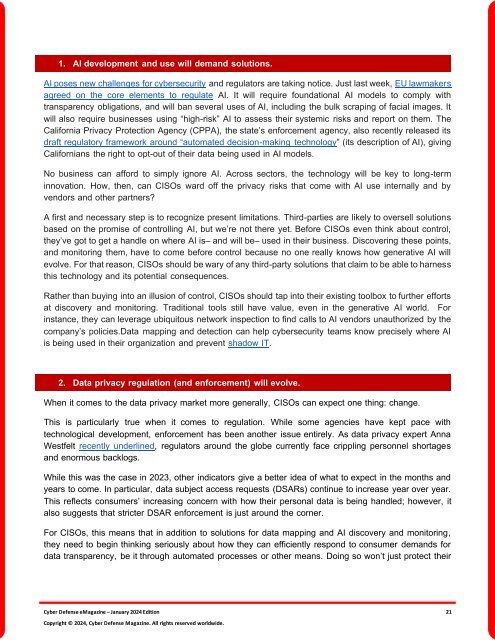The Cyber Defense eMagazine January Edition for 2024
Cyber Defense eMagazine January Edition for 2024 #CDM #CYBERDEFENSEMAG @CyberDefenseMag by @Miliefsky a world-renowned cyber security expert and the Publisher of Cyber Defense Magazine as part of the Cyber Defense Media Group as well as Yan Ross, Editor-in-Chief and many more writers, partners and supporters who make this an awesome publication! 201 page January Edition fully packed with some of our best content. Thank you all and to our readers! OSINT ROCKS! #CDM #CDMG #OSINT #CYBERSECURITY #INFOSEC #BEST #PRACTICES #TIPS #TECHNIQUES
Cyber Defense eMagazine January Edition for 2024 #CDM #CYBERDEFENSEMAG @CyberDefenseMag by @Miliefsky a world-renowned cyber security expert and the Publisher of Cyber Defense Magazine as part of the Cyber Defense Media Group as well as Yan Ross, Editor-in-Chief and many more writers, partners and supporters who make this an awesome publication! 201 page January Edition fully packed with some of our best content. Thank you all and to our readers! OSINT ROCKS! #CDM #CDMG #OSINT #CYBERSECURITY #INFOSEC #BEST #PRACTICES #TIPS #TECHNIQUES
Create successful ePaper yourself
Turn your PDF publications into a flip-book with our unique Google optimized e-Paper software.
1. AI development and use will demand solutions.<br />
AI poses new challenges <strong>for</strong> cybersecurity and regulators are taking notice. Just last week, EU lawmakers<br />
agreed on the core elements to regulate AI. It will require foundational AI models to comply with<br />
transparency obligations, and will ban several uses of AI, including the bulk scraping of facial images. It<br />
will also require businesses using “high-risk” AI to assess their systemic risks and report on them. <strong>The</strong><br />
Cali<strong>for</strong>nia Privacy Protection Agency (CPPA), the state’s en<strong>for</strong>cement agency, also recently released its<br />
draft regulatory framework around “automated decision-making technology” (its description of AI), giving<br />
Cali<strong>for</strong>nians the right to opt-out of their data being used in AI models.<br />
No business can af<strong>for</strong>d to simply ignore AI. Across sectors, the technology will be key to long-term<br />
innovation. How, then, can CISOs ward off the privacy risks that come with AI use internally and by<br />
vendors and other partners?<br />
A first and necessary step is to recognize present limitations. Third-parties are likely to oversell solutions<br />
based on the promise of controlling AI, but we’re not there yet. Be<strong>for</strong>e CISOs even think about control,<br />
they’ve got to get a handle on where AI is– and will be– used in their business. Discovering these points,<br />
and monitoring them, have to come be<strong>for</strong>e control because no one really knows how generative AI will<br />
evolve. For that reason, CISOs should be wary of any third-party solutions that claim to be able to harness<br />
this technology and its potential consequences.<br />
Rather than buying into an illusion of control, CISOs should tap into their existing toolbox to further ef<strong>for</strong>ts<br />
at discovery and monitoring. Traditional tools still have value, even in the generative AI world. For<br />
instance, they can leverage ubiquitous network inspection to find calls to AI vendors unauthorized by the<br />
company’s policies.Data mapping and detection can help cybersecurity teams know precisely where AI<br />
is being used in their organization and prevent shadow IT.<br />
2. Data privacy regulation (and en<strong>for</strong>cement) will evolve.<br />
When it comes to the data privacy market more generally, CISOs can expect one thing: change.<br />
This is particularly true when it comes to regulation. While some agencies have kept pace with<br />
technological development, en<strong>for</strong>cement has been another issue entirely. As data privacy expert Anna<br />
Westfelt recently underlined, regulators around the globe currently face crippling personnel shortages<br />
and enormous backlogs.<br />
While this was the case in 2023, other indicators give a better idea of what to expect in the months and<br />
years to come. In particular, data subject access requests (DSARs) continue to increase year over year.<br />
This reflects consumers’ increasing concern with how their personal data is being handled; however, it<br />
also suggests that stricter DSAR en<strong>for</strong>cement is just around the corner.<br />
For CISOs, this means that in addition to solutions <strong>for</strong> data mapping and AI discovery and monitoring,<br />
they need to begin thinking seriously about how they can efficiently respond to consumer demands <strong>for</strong><br />
data transparency, be it through automated processes or other means. Doing so won’t just protect their<br />
<strong>Cyber</strong> <strong>Defense</strong> <strong>eMagazine</strong> – <strong>January</strong> <strong>2024</strong> <strong>Edition</strong> 21<br />
Copyright © <strong>2024</strong>, <strong>Cyber</strong> <strong>Defense</strong> Magazine. All rights reserved worldwide.

















